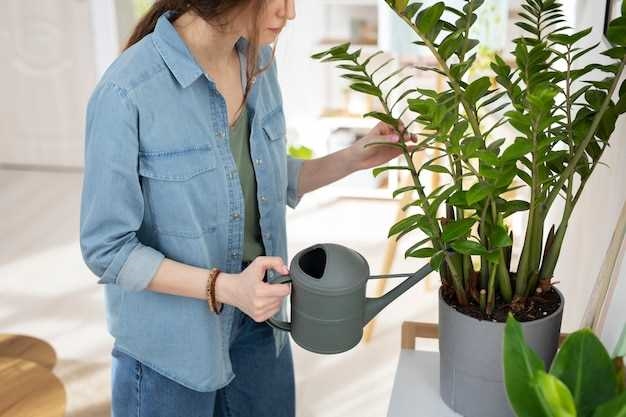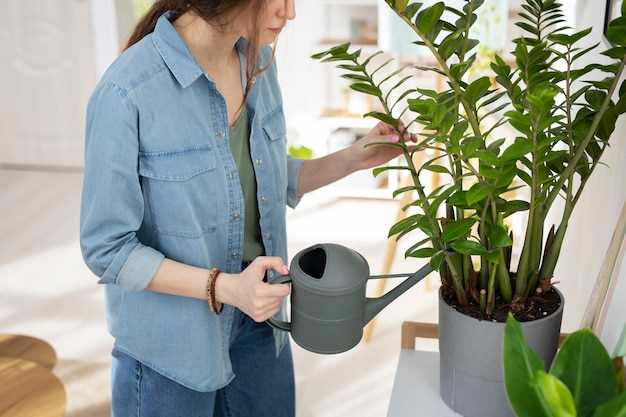

When it comes to tending to your beloved garden, a trusty watering can is an indispensable tool. Whether you’re nurturing delicate flowers or nourishing robust vegetables, this essential equipment ensures your plants receive the hydration they need to thrive. However, like any other gardening implement, your watering can requires regular maintenance to remain in optimal condition. In this article, we will explore the crucial steps you can take to keep your watering can clean, store it properly, and extend its lifespan.
Preserving the cleanliness of your watering can is paramount to prevent the spread of diseases and ensure the health of your plants. Over time, mineral deposits, algae, and other debris can accumulate inside the can, compromising its functionality. Regular cleaning is essential to remove these impurities and maintain the purity of the water you provide to your plants.
But how exactly can you clean your watering can effectively? Firstly, start by emptying any remaining water from the can and rinsing it thoroughly. Next, mix a solution of mild dish soap and warm water. Use a scrub brush or sponge to scrub the interior and exterior of the can, paying special attention to the spout and handle. Rinse the can thoroughly to remove any soap residue, and allow it to air dry completely before storing it.
Importance of Regular Cleaning for Watering Cans

Regular cleaning is an essential aspect of maintaining the quality and functionality of your watering cans. By regularly cleaning your watering cans, you can ensure that they remain in optimal condition and continue to provide efficient watering for your plants.
Keeping your watering cans clean helps prevent the buildup of dirt, debris, and other contaminants that can negatively impact the health of your plants. These contaminants can introduce harmful bacteria, fungi, or pests that may harm your plants and hinder their growth.
Regular cleaning also helps to prevent the formation of mineral deposits, such as lime or rust, which can accumulate over time. These deposits can clog the nozzle or spout of your watering can, reducing its effectiveness and causing uneven water distribution.
Furthermore, cleaning your watering cans regularly helps to remove any residual chemicals or fertilizers that may have been used in previous watering sessions. This ensures that your plants receive clean and uncontaminated water, promoting their overall health and vitality.
By incorporating regular cleaning into your watering can maintenance routine, you can extend the lifespan of your watering cans. Cleaning helps to prevent corrosion, deterioration, and damage that can occur over time due to neglect or improper care.
To clean your watering cans effectively, consider using a mild detergent or vinegar solution to remove dirt and stains. Scrub the interior and exterior surfaces with a brush or sponge, paying close attention to hard-to-reach areas. Rinse thoroughly with clean water and allow the watering can to air dry before storing.
Remember, a clean watering can is not only beneficial for your plants but also for your own gardening experience. It ensures that you have a reliable and efficient tool at hand whenever you need to water your plants, making the process more enjoyable and rewarding.
Step-by-Step Guide to Cleaning Your Watering Can
Keeping your gardening equipment in top condition is essential for maintaining a healthy and thriving garden. In this section, we will provide you with a detailed step-by-step guide on how to effectively clean your watering can, ensuring its longevity and optimal performance.
- Empty the contents of your watering can and rinse it thoroughly with clean water.
- Prepare a cleaning solution by mixing a mild detergent or dish soap with warm water.
- Using a sponge or soft brush, scrub the interior and exterior surfaces of the watering can with the cleaning solution. Pay special attention to any stubborn dirt or residue.
- Rinse the watering can again with clean water to remove any soap residue.
- Inspect the spout and nozzle for any clogs or blockages. Use a small brush or toothpick to remove any debris that may be obstructing the flow of water.
- For stubborn stains or mineral deposits, you can soak the watering can in a mixture of equal parts vinegar and water for a few hours. This will help dissolve and loosen the buildup.
- After soaking, scrub the affected areas with a brush or sponge to remove the stains or deposits.
- Rinse the watering can thoroughly with clean water to remove any vinegar residue.
- Allow the watering can to air dry completely before storing it.
- Store the watering can in a cool, dry place to prevent the growth of mold or mildew.
By following these simple steps, you can ensure that your watering can remains clean, free from debris, and ready for use whenever you need it. Regular cleaning and maintenance will not only extend the lifespan of your watering can but also contribute to the overall health and beauty of your garden.
Tips for Properly Storing Your Watering Can
When it comes to maintaining the longevity of your watering can, proper storage is key. By storing your watering can correctly, you can ensure that it remains in good condition and ready for use whenever you need it. In this section, we will provide you with some helpful tips on how to store your watering can effectively.
1. Choose a Suitable Location
Find a cool and dry place to store your watering can. Avoid areas that are exposed to direct sunlight or extreme temperatures, as these can cause damage to the material of the can. It is also important to keep your watering can away from any chemicals or substances that could potentially corrode or contaminate it.
2. Clean and Dry Thoroughly
Prior to storing your watering can, make sure to clean it thoroughly. Remove any dirt, debris, or residue from the can using a mild detergent and water. Rinse it well and allow it to dry completely before storing. This will help prevent the growth of mold or bacteria and keep your watering can in optimal condition.
| Storage Tips | Do’s | Don’ts |
|---|---|---|
| Use a cover | Protect your watering can from dust and dirt by using a cover or a plastic bag. | Don’t store your watering can without any protection, as it can accumulate dust and debris. |
| Elevate it | Place your watering can on a shelf or a raised surface to prevent it from sitting directly on the ground. | Avoid storing your watering can on the floor, as it can be more susceptible to damage and moisture. |
| Check for leaks | Before storing, ensure that there are no leaks or cracks in your watering can. Repair or replace any damaged parts. | Don’t store a leaking watering can, as it can cause water damage to the surrounding area. |
By following these tips, you can ensure that your watering can remains in good condition during storage, ready to be used whenever you need it. Proper storage not only extends the lifespan of your watering can but also helps maintain its functionality and effectiveness.
How to Prevent Algae and Mold Growth in Your Watering Can
Ensuring the cleanliness and longevity of your watering can is essential for maintaining healthy plants. One common issue that can arise is the growth of algae and mold, which can negatively impact the quality of the water and potentially harm your plants. In this section, we will explore effective methods to prevent the growth of algae and mold in your watering can.
Regular Cleaning: To prevent the buildup of algae and mold, it is important to clean your watering can regularly. After each use, thoroughly rinse the can with clean water to remove any remaining residue. Additionally, consider using a mild detergent or vinegar solution to scrub the interior of the can, ensuring all surfaces are clean and free from any potential contaminants.
Proper Drying: After cleaning your watering can, it is crucial to allow it to dry completely before storing it. Moisture is a breeding ground for algae and mold, so ensuring the can is completely dry will help prevent their growth. Leave the can in a well-ventilated area or use a towel to dry it thoroughly, paying special attention to any hard-to-reach areas.
Storage in a Dry Area: When not in use, store your watering can in a dry area. Avoid leaving it outdoors or in a damp environment, as this can promote the growth of algae and mold. Instead, find a cool, dry place to store the can, such as a shed or garage. If storing it indoors, ensure it is not placed near any sources of moisture or humidity.
Using Clean Water: Another important step in preventing algae and mold growth is to use clean water in your watering can. Avoid using water from ponds, lakes, or other natural sources that may contain algae spores. Instead, opt for tap water or filtered water to minimize the risk of introducing algae or mold into your can.
Regular Inspections: Lastly, make it a habit to regularly inspect your watering can for any signs of algae or mold growth. Check the interior and exterior of the can for any discoloration, slimy residue, or unpleasant odors. If you notice any of these signs, take immediate action to clean and disinfect the can to prevent further growth.
By following these preventative measures, you can ensure that your watering can remains free from algae and mold, providing clean and healthy water for your plants. Remember, a well-maintained watering can is essential for the overall health and vitality of your garden.
Extending the Lifespan of Your Watering Can: Dos and Don’ts
When it comes to ensuring the longevity of your watering can, there are certain actions you should take and others you should avoid. By following these dos and don’ts, you can maximize the lifespan of your watering can and continue to enjoy its functionality for years to come.
Do: Clean your watering can regularly
Regular cleaning is essential for maintaining the quality and effectiveness of your watering can. By removing dirt, debris, and residue from the can, you can prevent clogs and ensure a smooth flow of water. Use mild soap and water to clean both the inside and outside of the can, and rinse thoroughly to remove any soap residue.
Don’t: Use harsh chemicals or abrasive materials
Avoid using harsh chemicals or abrasive materials when cleaning your watering can, as they can damage the surface and compromise its durability. Instead, opt for gentle cleaning solutions and soft brushes or sponges to remove any stubborn stains or buildup.
| Do | Don’t |
|---|---|
| Store your watering can in a dry and sheltered area | Leave your watering can exposed to harsh weather conditions |
| Inspect your watering can for any signs of damage | Ignore any cracks or leaks in your watering can |
| Empty the can after each use to prevent stagnant water | Leave water sitting in your watering can for extended periods |
| Replace worn-out parts or repair any damages | Continue using a watering can with broken or malfunctioning components |
By following these dos and don’ts, you can ensure that your watering can remains in optimal condition and serves you well throughout its lifespan. Taking proper care of your watering can not only extends its longevity but also enhances your gardening experience.
Additional Maintenance Tips for Your Watering Can
Enhancing the longevity and functionality of your watering can involves more than just the basic cleaning and storage practices. In this section, we will explore some additional tips and techniques to ensure your watering can remains in optimal condition for an extended period of time.
1. Proper Drying
After cleaning your watering can, it is crucial to ensure that it is thoroughly dried before storing it. Excess moisture left inside the can may lead to the growth of mold or mildew, which can compromise its durability and contaminate the water used for watering your plants. To effectively dry your watering can, leave it in a well-ventilated area or use a clean cloth to wipe away any remaining moisture.
2. Regular Inspections
Periodically inspecting your watering can is essential for identifying any signs of damage or wear. Check for cracks, leaks, or rust, as these can affect the can’s functionality and potentially harm your plants. If any issues are detected, address them promptly by repairing or replacing the affected parts. Regular inspections will help you catch problems early on and prevent further damage.
Remember: By implementing these additional maintenance tips, you can ensure that your watering can remains in excellent condition, allowing you to efficiently care for your plants and enjoy the benefits of a well-maintained gardening tool.





